Reflection on Transition to Professional Practice: Nursing Handover
VerifiedAdded on 2022/10/07
|8
|1599
|17
Report
AI Summary
This report is a reflective analysis of a student's experience during a nursing handover, framed within the context of the National Safety and Quality Health Service (NSQHS) Standards and utilizing Gibbs' reflective cycle. The report begins with a detailed description of the incident, including the student's feelings and initial reactions. It then proceeds to evaluate the event, identifying areas of weakness and strengths based on the NSQHS standards. The analysis delves deeper, exploring the reasons behind the student's performance, including confidence issues and the challenges of patient care handover. Finally, the report concludes with an action plan, outlining steps the student intends to take to improve their handover skills and overall professional practice, supported by relevant literature and research.
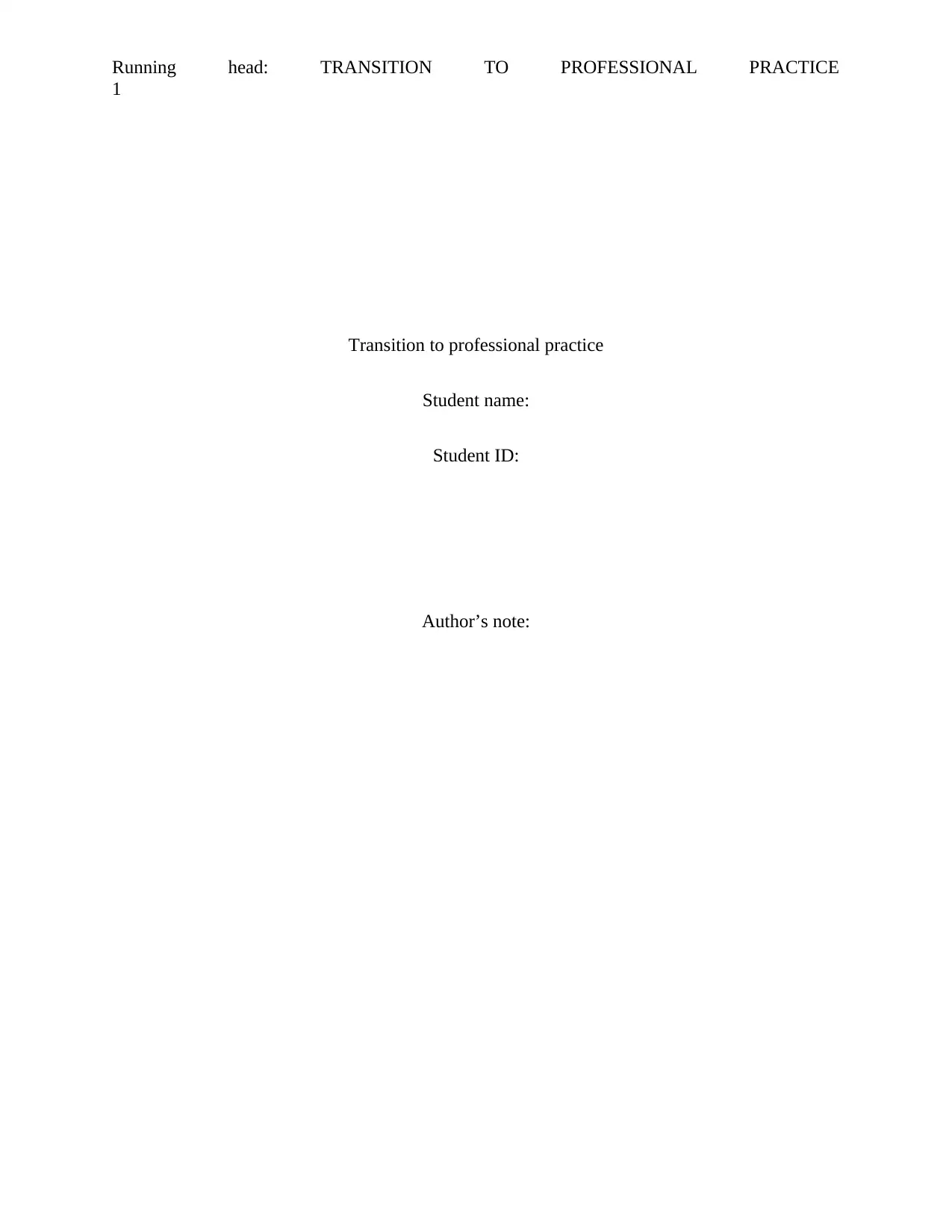
Running head: TRANSITION TO PROFESSIONAL PRACTICE
1
Transition to professional practice
Student name:
Student ID:
Author’s note:
1
Transition to professional practice
Student name:
Student ID:
Author’s note:
Paraphrase This Document
Need a fresh take? Get an instant paraphrase of this document with our AI Paraphraser
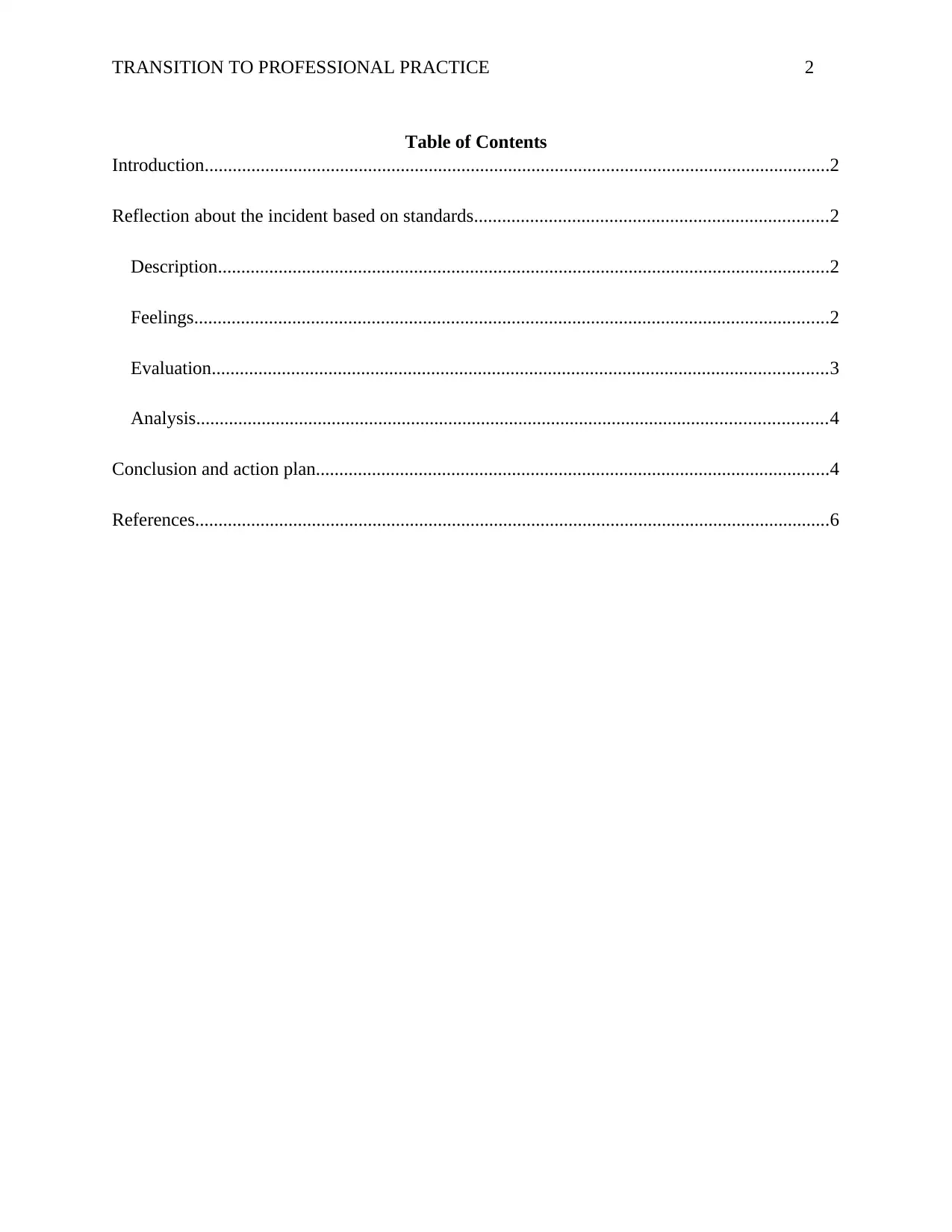
TRANSITION TO PROFESSIONAL PRACTICE 2
Table of Contents
Introduction......................................................................................................................................2
Reflection about the incident based on standards............................................................................2
Description...................................................................................................................................2
Feelings........................................................................................................................................2
Evaluation....................................................................................................................................3
Analysis.......................................................................................................................................4
Conclusion and action plan..............................................................................................................4
References........................................................................................................................................6
Table of Contents
Introduction......................................................................................................................................2
Reflection about the incident based on standards............................................................................2
Description...................................................................................................................................2
Feelings........................................................................................................................................2
Evaluation....................................................................................................................................3
Analysis.......................................................................................................................................4
Conclusion and action plan..............................................................................................................4
References........................................................................................................................................6
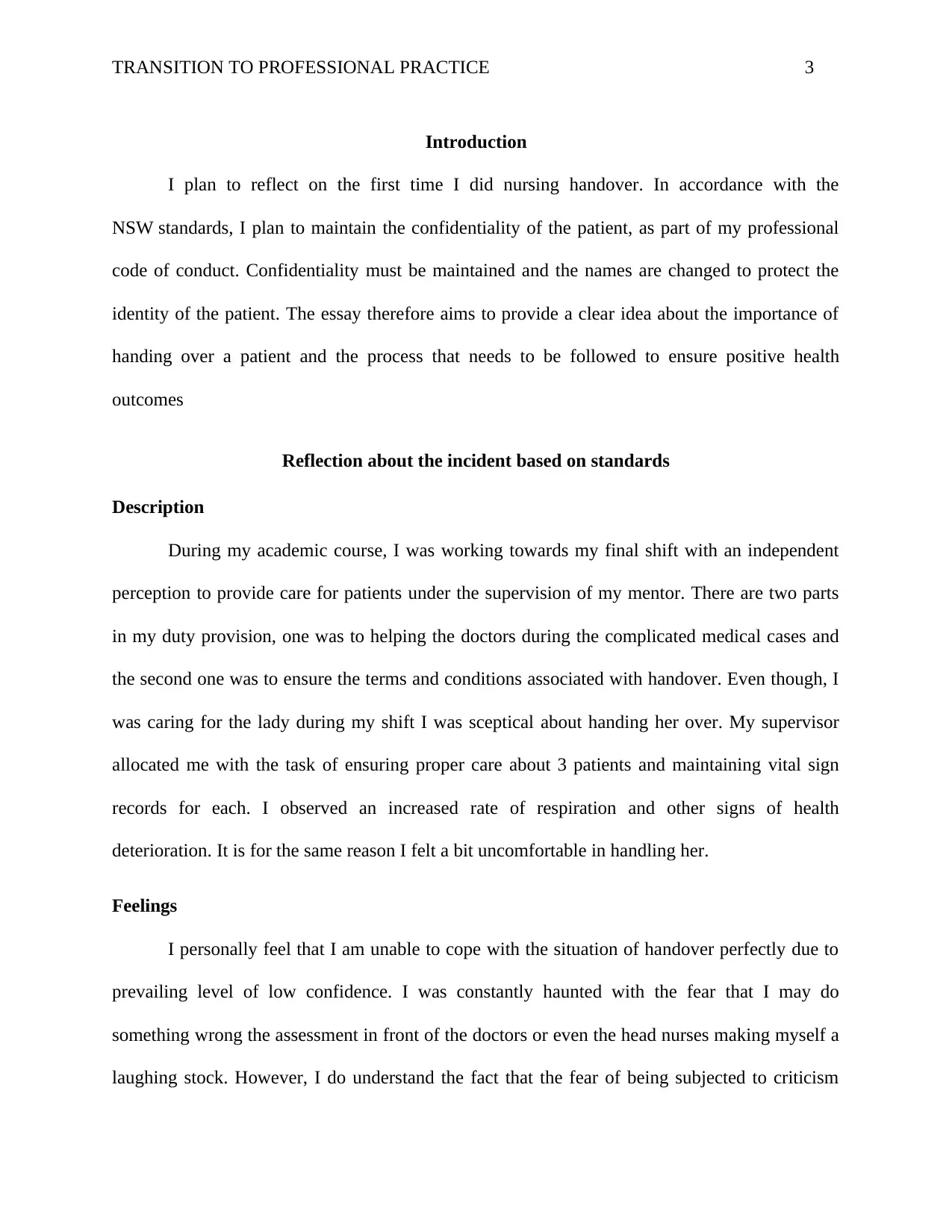
TRANSITION TO PROFESSIONAL PRACTICE 3
Introduction
I plan to reflect on the first time I did nursing handover. In accordance with the
NSW standards, I plan to maintain the confidentiality of the patient, as part of my professional
code of conduct. Confidentiality must be maintained and the names are changed to protect the
identity of the patient. The essay therefore aims to provide a clear idea about the importance of
handing over a patient and the process that needs to be followed to ensure positive health
outcomes
Reflection about the incident based on standards
Description
During my academic course, I was working towards my final shift with an independent
perception to provide care for patients under the supervision of my mentor. There are two parts
in my duty provision, one was to helping the doctors during the complicated medical cases and
the second one was to ensure the terms and conditions associated with handover. Even though, I
was caring for the lady during my shift I was sceptical about handing her over. My supervisor
allocated me with the task of ensuring proper care about 3 patients and maintaining vital sign
records for each. I observed an increased rate of respiration and other signs of health
deterioration. It is for the same reason I felt a bit uncomfortable in handling her.
Feelings
I personally feel that I am unable to cope with the situation of handover perfectly due to
prevailing level of low confidence. I was constantly haunted with the fear that I may do
something wrong the assessment in front of the doctors or even the head nurses making myself a
laughing stock. However, I do understand the fact that the fear of being subjected to criticism
Introduction
I plan to reflect on the first time I did nursing handover. In accordance with the
NSW standards, I plan to maintain the confidentiality of the patient, as part of my professional
code of conduct. Confidentiality must be maintained and the names are changed to protect the
identity of the patient. The essay therefore aims to provide a clear idea about the importance of
handing over a patient and the process that needs to be followed to ensure positive health
outcomes
Reflection about the incident based on standards
Description
During my academic course, I was working towards my final shift with an independent
perception to provide care for patients under the supervision of my mentor. There are two parts
in my duty provision, one was to helping the doctors during the complicated medical cases and
the second one was to ensure the terms and conditions associated with handover. Even though, I
was caring for the lady during my shift I was sceptical about handing her over. My supervisor
allocated me with the task of ensuring proper care about 3 patients and maintaining vital sign
records for each. I observed an increased rate of respiration and other signs of health
deterioration. It is for the same reason I felt a bit uncomfortable in handling her.
Feelings
I personally feel that I am unable to cope with the situation of handover perfectly due to
prevailing level of low confidence. I was constantly haunted with the fear that I may do
something wrong the assessment in front of the doctors or even the head nurses making myself a
laughing stock. However, I do understand the fact that the fear of being subjected to criticism
⊘ This is a preview!⊘
Do you want full access?
Subscribe today to unlock all pages.

Trusted by 1+ million students worldwide
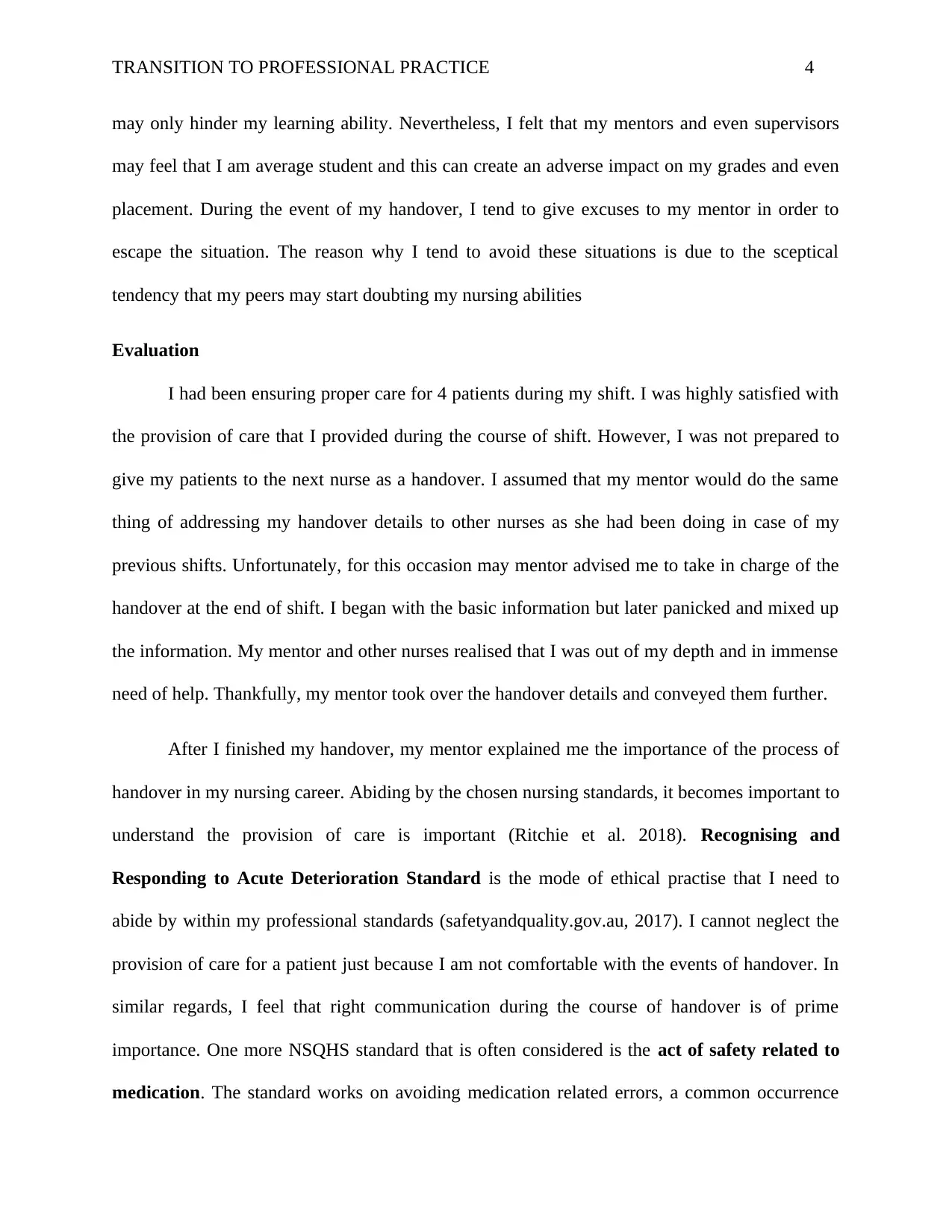
TRANSITION TO PROFESSIONAL PRACTICE 4
may only hinder my learning ability. Nevertheless, I felt that my mentors and even supervisors
may feel that I am average student and this can create an adverse impact on my grades and even
placement. During the event of my handover, I tend to give excuses to my mentor in order to
escape the situation. The reason why I tend to avoid these situations is due to the sceptical
tendency that my peers may start doubting my nursing abilities
Evaluation
I had been ensuring proper care for 4 patients during my shift. I was highly satisfied with
the provision of care that I provided during the course of shift. However, I was not prepared to
give my patients to the next nurse as a handover. I assumed that my mentor would do the same
thing of addressing my handover details to other nurses as she had been doing in case of my
previous shifts. Unfortunately, for this occasion may mentor advised me to take in charge of the
handover at the end of shift. I began with the basic information but later panicked and mixed up
the information. My mentor and other nurses realised that I was out of my depth and in immense
need of help. Thankfully, my mentor took over the handover details and conveyed them further.
After I finished my handover, my mentor explained me the importance of the process of
handover in my nursing career. Abiding by the chosen nursing standards, it becomes important to
understand the provision of care is important (Ritchie et al. 2018). Recognising and
Responding to Acute Deterioration Standard is the mode of ethical practise that I need to
abide by within my professional standards (safetyandquality.gov.au, 2017). I cannot neglect the
provision of care for a patient just because I am not comfortable with the events of handover. In
similar regards, I feel that right communication during the course of handover is of prime
importance. One more NSQHS standard that is often considered is the act of safety related to
medication. The standard works on avoiding medication related errors, a common occurrence
may only hinder my learning ability. Nevertheless, I felt that my mentors and even supervisors
may feel that I am average student and this can create an adverse impact on my grades and even
placement. During the event of my handover, I tend to give excuses to my mentor in order to
escape the situation. The reason why I tend to avoid these situations is due to the sceptical
tendency that my peers may start doubting my nursing abilities
Evaluation
I had been ensuring proper care for 4 patients during my shift. I was highly satisfied with
the provision of care that I provided during the course of shift. However, I was not prepared to
give my patients to the next nurse as a handover. I assumed that my mentor would do the same
thing of addressing my handover details to other nurses as she had been doing in case of my
previous shifts. Unfortunately, for this occasion may mentor advised me to take in charge of the
handover at the end of shift. I began with the basic information but later panicked and mixed up
the information. My mentor and other nurses realised that I was out of my depth and in immense
need of help. Thankfully, my mentor took over the handover details and conveyed them further.
After I finished my handover, my mentor explained me the importance of the process of
handover in my nursing career. Abiding by the chosen nursing standards, it becomes important to
understand the provision of care is important (Ritchie et al. 2018). Recognising and
Responding to Acute Deterioration Standard is the mode of ethical practise that I need to
abide by within my professional standards (safetyandquality.gov.au, 2017). I cannot neglect the
provision of care for a patient just because I am not comfortable with the events of handover. In
similar regards, I feel that right communication during the course of handover is of prime
importance. One more NSQHS standard that is often considered is the act of safety related to
medication. The standard works on avoiding medication related errors, a common occurrence
Paraphrase This Document
Need a fresh take? Get an instant paraphrase of this document with our AI Paraphraser
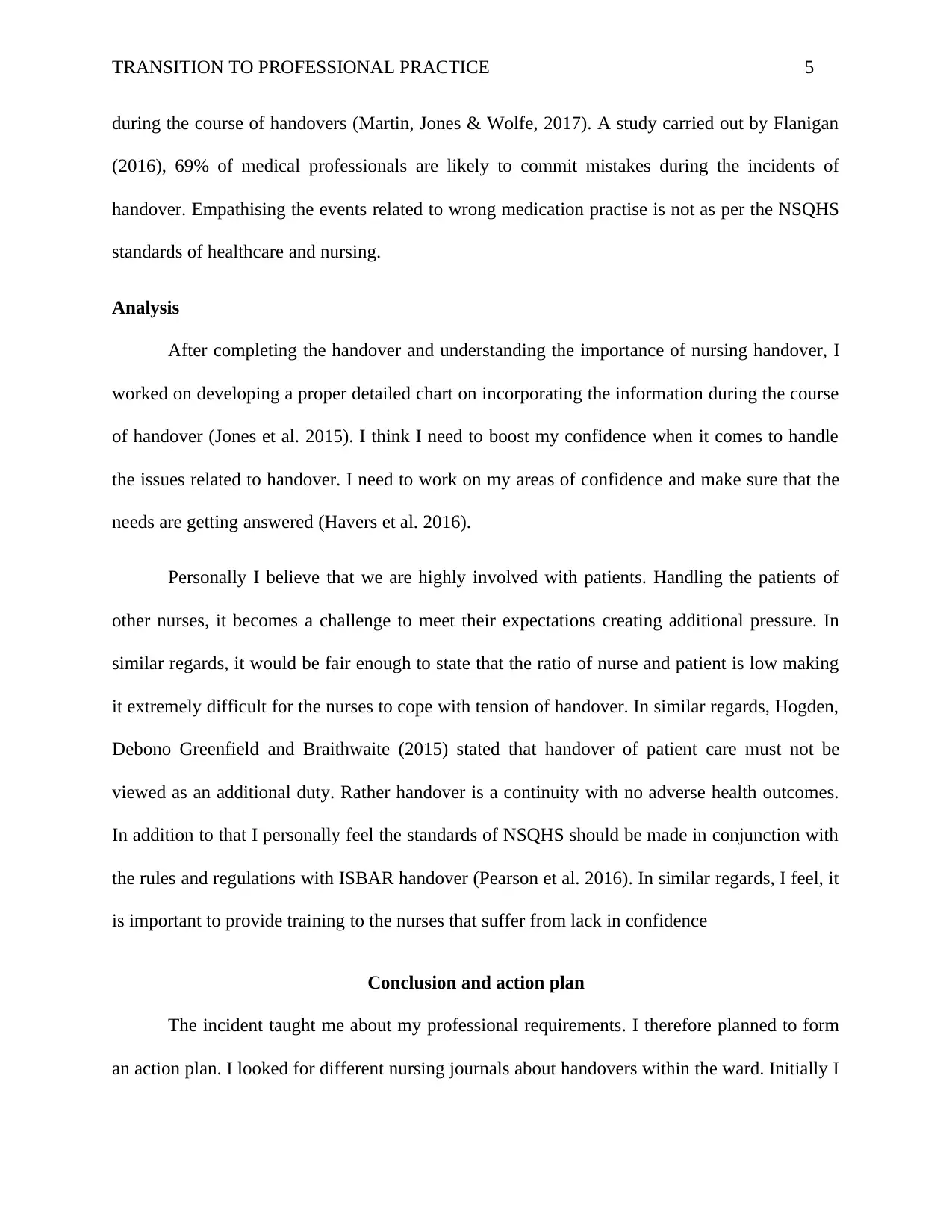
TRANSITION TO PROFESSIONAL PRACTICE 5
during the course of handovers (Martin, Jones & Wolfe, 2017). A study carried out by Flanigan
(2016), 69% of medical professionals are likely to commit mistakes during the incidents of
handover. Empathising the events related to wrong medication practise is not as per the NSQHS
standards of healthcare and nursing.
Analysis
After completing the handover and understanding the importance of nursing handover, I
worked on developing a proper detailed chart on incorporating the information during the course
of handover (Jones et al. 2015). I think I need to boost my confidence when it comes to handle
the issues related to handover. I need to work on my areas of confidence and make sure that the
needs are getting answered (Havers et al. 2016).
Personally I believe that we are highly involved with patients. Handling the patients of
other nurses, it becomes a challenge to meet their expectations creating additional pressure. In
similar regards, it would be fair enough to state that the ratio of nurse and patient is low making
it extremely difficult for the nurses to cope with tension of handover. In similar regards, Hogden,
Debono Greenfield and Braithwaite (2015) stated that handover of patient care must not be
viewed as an additional duty. Rather handover is a continuity with no adverse health outcomes.
In addition to that I personally feel the standards of NSQHS should be made in conjunction with
the rules and regulations with ISBAR handover (Pearson et al. 2016). In similar regards, I feel, it
is important to provide training to the nurses that suffer from lack in confidence
Conclusion and action plan
The incident taught me about my professional requirements. I therefore planned to form
an action plan. I looked for different nursing journals about handovers within the ward. Initially I
during the course of handovers (Martin, Jones & Wolfe, 2017). A study carried out by Flanigan
(2016), 69% of medical professionals are likely to commit mistakes during the incidents of
handover. Empathising the events related to wrong medication practise is not as per the NSQHS
standards of healthcare and nursing.
Analysis
After completing the handover and understanding the importance of nursing handover, I
worked on developing a proper detailed chart on incorporating the information during the course
of handover (Jones et al. 2015). I think I need to boost my confidence when it comes to handle
the issues related to handover. I need to work on my areas of confidence and make sure that the
needs are getting answered (Havers et al. 2016).
Personally I believe that we are highly involved with patients. Handling the patients of
other nurses, it becomes a challenge to meet their expectations creating additional pressure. In
similar regards, it would be fair enough to state that the ratio of nurse and patient is low making
it extremely difficult for the nurses to cope with tension of handover. In similar regards, Hogden,
Debono Greenfield and Braithwaite (2015) stated that handover of patient care must not be
viewed as an additional duty. Rather handover is a continuity with no adverse health outcomes.
In addition to that I personally feel the standards of NSQHS should be made in conjunction with
the rules and regulations with ISBAR handover (Pearson et al. 2016). In similar regards, I feel, it
is important to provide training to the nurses that suffer from lack in confidence
Conclusion and action plan
The incident taught me about my professional requirements. I therefore planned to form
an action plan. I looked for different nursing journals about handovers within the ward. Initially I
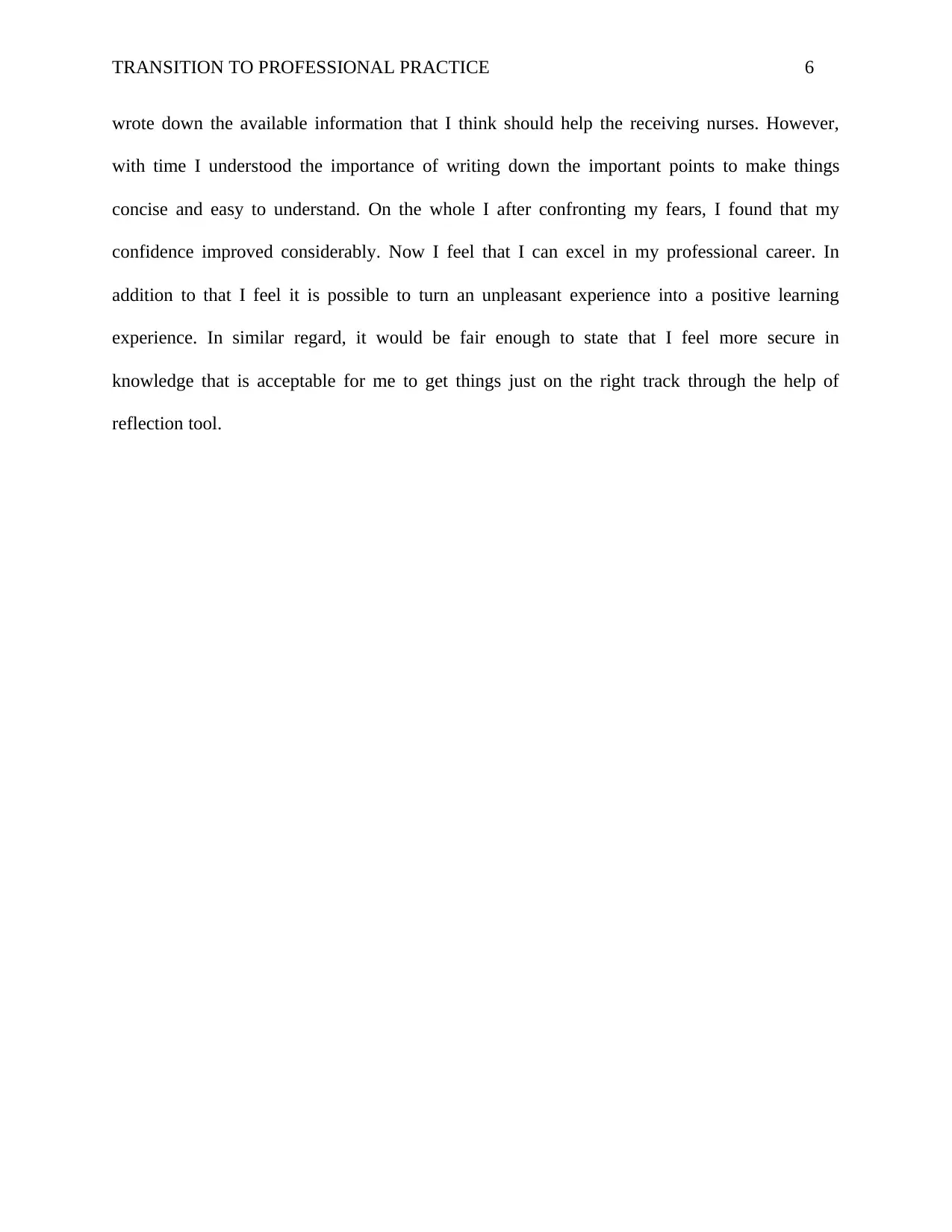
TRANSITION TO PROFESSIONAL PRACTICE 6
wrote down the available information that I think should help the receiving nurses. However,
with time I understood the importance of writing down the important points to make things
concise and easy to understand. On the whole I after confronting my fears, I found that my
confidence improved considerably. Now I feel that I can excel in my professional career. In
addition to that I feel it is possible to turn an unpleasant experience into a positive learning
experience. In similar regard, it would be fair enough to state that I feel more secure in
knowledge that is acceptable for me to get things just on the right track through the help of
reflection tool.
wrote down the available information that I think should help the receiving nurses. However,
with time I understood the importance of writing down the important points to make things
concise and easy to understand. On the whole I after confronting my fears, I found that my
confidence improved considerably. Now I feel that I can excel in my professional career. In
addition to that I feel it is possible to turn an unpleasant experience into a positive learning
experience. In similar regard, it would be fair enough to state that I feel more secure in
knowledge that is acceptable for me to get things just on the right track through the help of
reflection tool.
⊘ This is a preview!⊘
Do you want full access?
Subscribe today to unlock all pages.

Trusted by 1+ million students worldwide
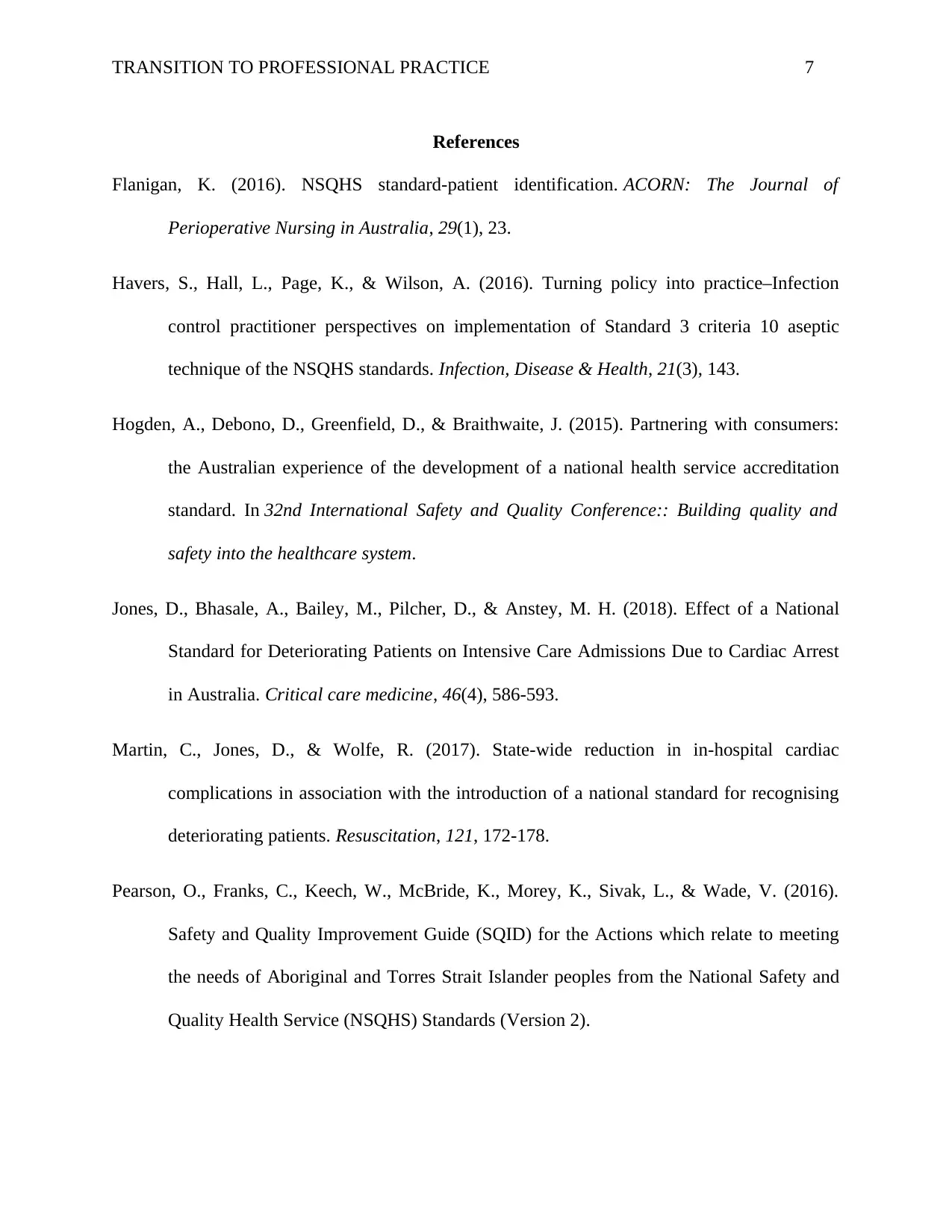
TRANSITION TO PROFESSIONAL PRACTICE 7
References
Flanigan, K. (2016). NSQHS standard-patient identification. ACORN: The Journal of
Perioperative Nursing in Australia, 29(1), 23.
Havers, S., Hall, L., Page, K., & Wilson, A. (2016). Turning policy into practice–Infection
control practitioner perspectives on implementation of Standard 3 criteria 10 aseptic
technique of the NSQHS standards. Infection, Disease & Health, 21(3), 143.
Hogden, A., Debono, D., Greenfield, D., & Braithwaite, J. (2015). Partnering with consumers:
the Australian experience of the development of a national health service accreditation
standard. In 32nd International Safety and Quality Conference:: Building quality and
safety into the healthcare system.
Jones, D., Bhasale, A., Bailey, M., Pilcher, D., & Anstey, M. H. (2018). Effect of a National
Standard for Deteriorating Patients on Intensive Care Admissions Due to Cardiac Arrest
in Australia. Critical care medicine, 46(4), 586-593.
Martin, C., Jones, D., & Wolfe, R. (2017). State-wide reduction in in-hospital cardiac
complications in association with the introduction of a national standard for recognising
deteriorating patients. Resuscitation, 121, 172-178.
Pearson, O., Franks, C., Keech, W., McBride, K., Morey, K., Sivak, L., & Wade, V. (2016).
Safety and Quality Improvement Guide (SQID) for the Actions which relate to meeting
the needs of Aboriginal and Torres Strait Islander peoples from the National Safety and
Quality Health Service (NSQHS) Standards (Version 2).
References
Flanigan, K. (2016). NSQHS standard-patient identification. ACORN: The Journal of
Perioperative Nursing in Australia, 29(1), 23.
Havers, S., Hall, L., Page, K., & Wilson, A. (2016). Turning policy into practice–Infection
control practitioner perspectives on implementation of Standard 3 criteria 10 aseptic
technique of the NSQHS standards. Infection, Disease & Health, 21(3), 143.
Hogden, A., Debono, D., Greenfield, D., & Braithwaite, J. (2015). Partnering with consumers:
the Australian experience of the development of a national health service accreditation
standard. In 32nd International Safety and Quality Conference:: Building quality and
safety into the healthcare system.
Jones, D., Bhasale, A., Bailey, M., Pilcher, D., & Anstey, M. H. (2018). Effect of a National
Standard for Deteriorating Patients on Intensive Care Admissions Due to Cardiac Arrest
in Australia. Critical care medicine, 46(4), 586-593.
Martin, C., Jones, D., & Wolfe, R. (2017). State-wide reduction in in-hospital cardiac
complications in association with the introduction of a national standard for recognising
deteriorating patients. Resuscitation, 121, 172-178.
Pearson, O., Franks, C., Keech, W., McBride, K., Morey, K., Sivak, L., & Wade, V. (2016).
Safety and Quality Improvement Guide (SQID) for the Actions which relate to meeting
the needs of Aboriginal and Torres Strait Islander peoples from the National Safety and
Quality Health Service (NSQHS) Standards (Version 2).
Paraphrase This Document
Need a fresh take? Get an instant paraphrase of this document with our AI Paraphraser
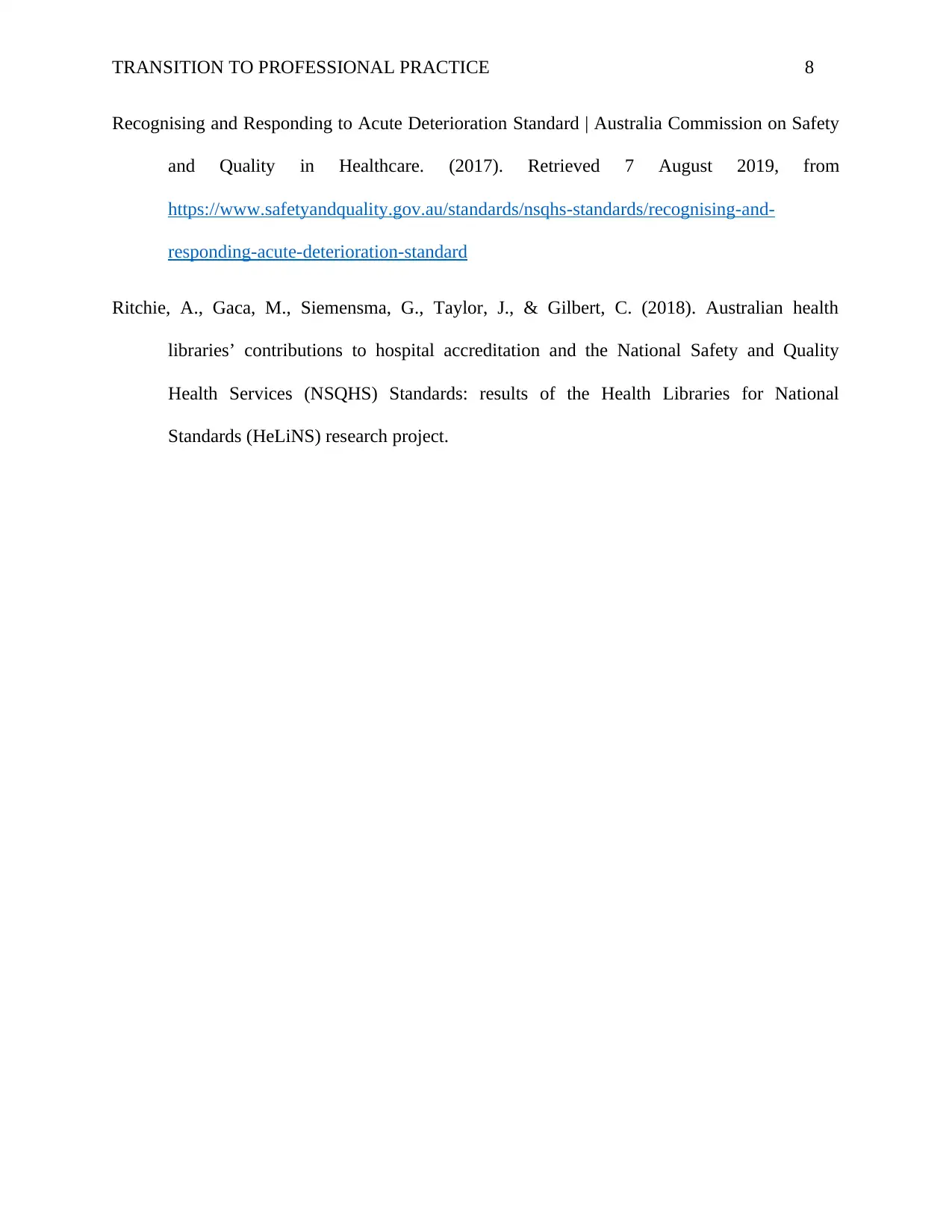
TRANSITION TO PROFESSIONAL PRACTICE 8
Recognising and Responding to Acute Deterioration Standard | Australia Commission on Safety
and Quality in Healthcare. (2017). Retrieved 7 August 2019, from
https://www.safetyandquality.gov.au/standards/nsqhs-standards/recognising-and-
responding-acute-deterioration-standard
Ritchie, A., Gaca, M., Siemensma, G., Taylor, J., & Gilbert, C. (2018). Australian health
libraries’ contributions to hospital accreditation and the National Safety and Quality
Health Services (NSQHS) Standards: results of the Health Libraries for National
Standards (HeLiNS) research project.
Recognising and Responding to Acute Deterioration Standard | Australia Commission on Safety
and Quality in Healthcare. (2017). Retrieved 7 August 2019, from
https://www.safetyandquality.gov.au/standards/nsqhs-standards/recognising-and-
responding-acute-deterioration-standard
Ritchie, A., Gaca, M., Siemensma, G., Taylor, J., & Gilbert, C. (2018). Australian health
libraries’ contributions to hospital accreditation and the National Safety and Quality
Health Services (NSQHS) Standards: results of the Health Libraries for National
Standards (HeLiNS) research project.
1 out of 8
Related Documents
Your All-in-One AI-Powered Toolkit for Academic Success.
+13062052269
info@desklib.com
Available 24*7 on WhatsApp / Email
![[object Object]](/_next/static/media/star-bottom.7253800d.svg)
Unlock your academic potential
Copyright © 2020–2025 A2Z Services. All Rights Reserved. Developed and managed by ZUCOL.





